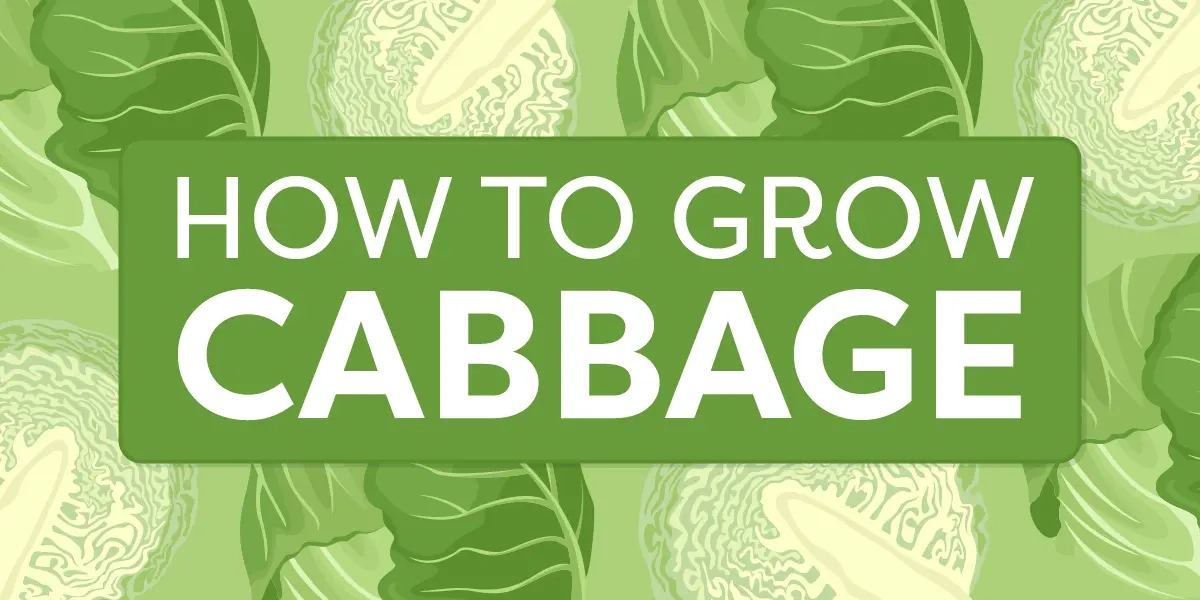Imagine an authentic German meal without cabbage. Unmöglich!
For hearty soups, slaws, and fermented dishes, cabbage is king in northern Europe.
This nutritious and filling vegetable originated in Europe and the Mediterranean, with evidence of early cultivation dating back over 4,000 years.
It grew wild in coastal areas, where ancient Greeks and Romans foraged. Through conquest, trade, and cultural assimilation, it became a staple food in northern Europe, Russia, China, and Japan.
In the USA, cabbage is associated with traditional Southern dishes like coleslaw and collard greens. Growing cabbage in Southern California may seem challenging due to the region’s warm climate and frequent droughts. Still, with sound horticultural practices and adapted varieties, it can thrive in your garden.
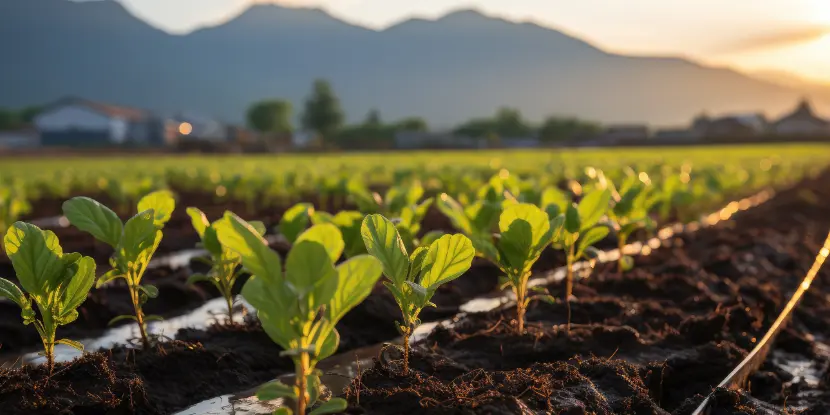
Young cabbage plants in a field.
Choosing the Right Variety
Several cabbage varieties are heat tolerant. These include:
- Early Jersey Wakefield
- Golden Acre
- Chinese cabbage
- Red Acre
- Napa or Savoy cabbage
Another consideration is the size of your garden and the space you’ve allocated for cabbage plants. Some varieties, such as Early Jersey Wakefield, are more compact and can be grown in smaller spaces, while others, like Napa cabbage, need room to spread out.
Know your cabbage before you plant the first seed!
Climate, Light & Soil Requirements
Cabbage prefers cool weather but can flourish in Southern California’s mild winters and moderate summers. Your cabbage patch should receive ample direct sunlight, ideally six to eight hours a day, and have well-drained soil with a pH between 6.0 and 7.5.

A newly formed red cabbage head.
Soil Preparation
Choose a spot in your garden that offers good air circulation and protection from strong winds. Avoid areas prone to waterlogging. Cabbage roots are susceptible to rot in soggy soil.
- Test the soil pH and adjust it, if necessary. Add lime to increase pH or sulfur to decrease it.
- Remove weeds, rocks, and debris from the planting area. This will ensure that your cabbage plants can grow unhindered.
- Use a tiller or garden fork to loosen the soil to a depth of at least 12-15 inches. Tilling improves drainage and makes it easier for cabbage roots to penetrate the soil.
- Enrich the soil by mixing in well-rotted manure or compost. This improves soil structure, aeration, and water retention while providing essential nutrients for your cabbage plants.
- Rake the soil smooth and level. This creates a uniform planting bed and prevents water pooling in low spots.
- If the soil is dry, water it lightly a day before planting. Moist soil makes transplanting easier and encourages quick root growth.
Planting Seeds or Seedlings
- If planting seeds, sow them indoors 6-8 weeks before the last frost date.
- Transplant seedlings into the garden once they’ve developed several true leaves.
- Space seedlings 12-18 inches apart.
- Water transplanted seedlings immediately to help them establish themselves in their new environment.
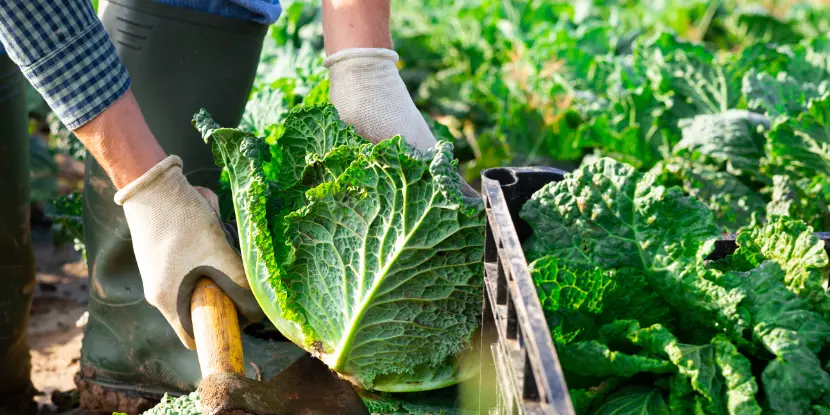
A freshly harvested Savoy cabbage.
Watering & Fertilizing
Cabbage needs consistent moisture throughout its growing season. Water deeply at least once weekly, providing 1-2 inches weekly.
- Water plants early in the morning to allow water on foliage to evaporate during the day and reduce the risk of fungal diseases.
- To prevent leaf diseases, aim water at the base of the plant rather than sprinkling it over the leaves.
- For the most efficient watering method, use a soaker hose or drip irrigation system, which sends water directly to the roots.
- Mulch around the cabbage plants to retain soil moisture and reduce evaporation.
- Avoid overwatering. Cabbage does poorly in soggy soil. Soil should be moist but well-drained.
Advantages of Drip Irrigation
- Saves Water: Drip irrigation minimizes evaporation and runoff by delivering water directly to the plant’s root zone.
- Reduces Weeds: Surrounding soil stays drier, discouraging weed growth.
- Saves Time: Drip irrigation systems can be automated, saving time and effort in the garden.
- Better Yield: A consistent and adequate water supply improves the health and productivity of cabbage plants.
Fertilizing
Cabbage plants require nutrient-rich soil to grow large and robust heads. Fertilizing is most critical at two stages of development:
- Two to three weeks after transplanting seedlings into the garden. This helps the plants recover from transplant shock and supports early growth.
- When the cabbage heads begin to form. This is crucial for developing full, dense heads.
Steps for Fertilizing Cabbage Plants
- Choose a balanced fertilizer, such as a 10-10-10 formula with an equal nitrogen, phosphorus, and potassium ratio.
- Apply the fertilizer around the base of the plant, keeping it several inches away from the stem to avoid burning the plant.
- Water the soil well to dissolve the fertilizer and carry nutrients to the plant’s roots.
- Alternatively, use a foliar feed for quick nutrient uptake, especially if the plant shows nutrient deficiency.
- Monitor your plants after fertilizing, and adjust your feeding schedule according to their growth and health. Cabbage plants growing in rich, well-amended soil require less frequent fertilization.
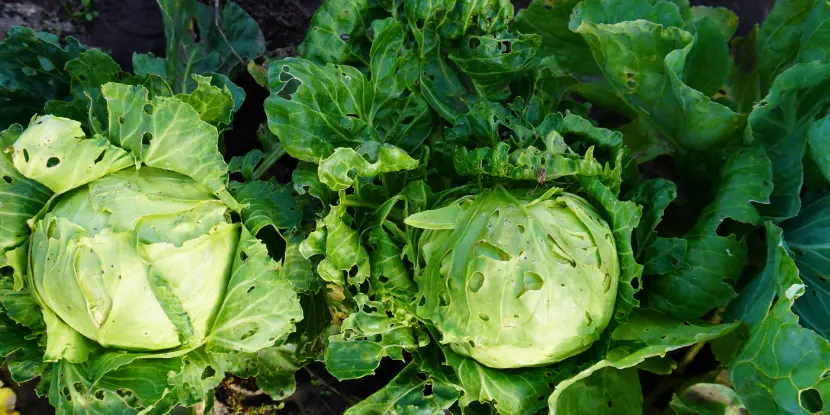
Cabbage damaged by uncontrolled pests.
Pest & Disease Management
Common problems include aphids, cabbage loopers, cutworms, and diseases like black rot, clubroot, and downy mildew. To manage these issues organically, consider the following approaches:
- Companion Planting: Herbs like thyme, dill, and mint planted near your cabbage can repel certain pests. Marigolds deter beetles and nematodes.
- Natural Predators: Encourage beneficial insects like ladybugs, lacewings, and predatory wasps in your garden. These predators naturally control aphids and other harmful pests.
- Row Covers: Install floating row covers to block pests physically. This barrier is particularly effective against moths and butterflies that lay eggs on the leaves.
- Neem Oil: Apply neem oil to control aphids, mites, and other pests. It’s safe for beneficial insects and acts as an antifeedant, growth regulator, and egg-laying deterrent.
- Organic Fungicides: For fungal diseases like downy mildew, use organic fungicides like copper sprays or baking soda solutions. Proper watering practices and adequate spacing are essential.
Companion Planting
Companion planting is the practice of closely planting different crops for the mutual benefit of pest control, pollination, and habitat for beneficial creatures.
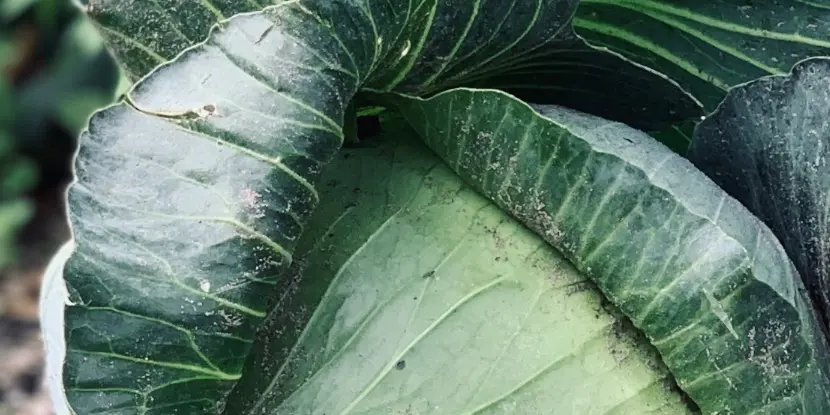
A cabbage head infested with aphids.
It maximizes space, increases crop productivity, and creates a more balanced ecosystem. For cabbage and other brassicas, these are some of the best companion plants:
- Aromatic herbs like dill, mint, rosemary, thyme, and sage repel common pests and attract beneficial insects.
- Marigolds can deter beetles and nematodes, while nasturtiums draw aphids away from cabbages.
- Due to their pungent scents, chives, garlic, onions, and leeks discourage aphids, moths, and flea beetles.
- Beans and peas can fix nitrogen in the soil, making it available to cabbage.
- Lettuce and spinach have shallow roots and don’t compete for nutrients. They can provide ground cover to retain soil moisture.
Harvesting Cabbage
Harvest cabbage when the heads feel firm and dense, typically 70-90 days after planting. Use a sharp knife to cut the head from the stem, leaving a few outer leaves intact to protect the head and extend its freshness.
After harvesting, remove any remaining plant parts from the soil to prevent disease and pest proliferation. Store cabbage in a cool, humid place to maintain its freshness for weeks.
Bon appétit!
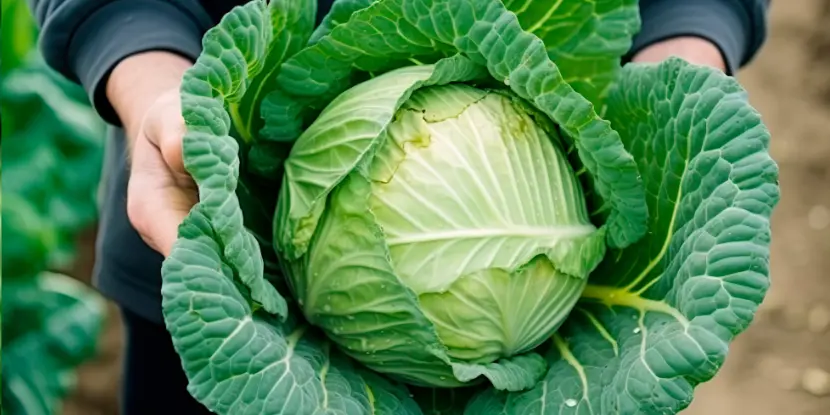
A harvested head of cabbage protected by outer leaves.
FAQs: Growing Cabbage
Q: Can cabbage grow in hot climates like Southern California?
Certain cabbage varieties are well-suited to the warm weather of Southern California if they receive adequate sunlight and moisture.
Q: Is it possible to grow cabbage during the winter?
With proper planning and selection of cold-tolerant varieties, cabbage can be grown in the winter or overwintered for early spring harvest.
Q: Can I grow cabbage in containers?
Yes, provided the containers are large enough to accommodate the plants and have good drainage.
Q: What companion plants should be avoided when planting cabbage?
Avoid planting strawberries, tomatoes, and grapes near cabbage, which can foster disease or pests. Brassicas also compete for nutrients with these plants, potentially hindering their growth.
Q: What’s the best way to store harvested cabbage?
Store harvested cabbage in a cool, humid place. Wrapped loosely in plastic and placed in a refrigerator, it can keep them fresh for several weeks.
Q: How do I prevent cabbages from splitting?
Dry conditions cause splitting. Water consistently and consider applying a thick layer of mulch to maintain even soil moisture. You can twist the head a quarter turn to disrupt root growth slightly.
Q: How often should I water my cabbage plants?
That depends on the soil moisture and weather conditions. Typically, 1-2 inches of water per week is enough. Deep watering encourages strong root growth.
Q: How do I manage large populations of aphids on my cabbage?
Hose them off with water, introduce natural predators, and apply neem oil or insecticidal soap. Regular monitoring and early intervention are the key to managing pest populations.
Q: How can I deal with snails and slugs naturally?
A barrier of diatomaceous earth around your cabbage plants can deter snails and slugs. Beer traps can attract and drown these pests. Inviting natural predators like birds and toads into your garden can also control their population.
Q: What is the best time of day to water cabbage plants?
Early morning is ideal for cabbage plants. This lets water reach deep into the soil before the day’s heat and prevents the leaves from staying wet overnight, which can lead to disease.
Q: Can I reuse the soil where I previously grew cabbage to plant other vegetables?
We recommend practicing crop rotation, especially with Brassica family members, to prevent soil depletion and reduce the risk of soil-borne diseases. If you must reuse the same soil, enrich it with compost and consider planting vegetables from different families, such as root vegetables or legumes, which have different nutrient needs and pest problems.

